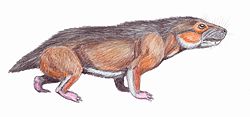Herpetogale
|
Microgomphodon Temporal range: Middle Triassic, Olenekian–Anisian |
|
|---|---|
 |
|
| Life restoration of Microgomphodon oligocynus | |
| Scientific classification | |
| Kingdom: | Animalia |
| Phylum: | Chordata |
| Order: | Therapsida |
| Suborder: | †Therocephalia |
| Family: | †Bauriidae |
| Genus: |
†Microgomphodon Seeley, 1895 |
| Type species | |
|
†Microgomphodon oligocynus Seeley, 1895 |
|
| Synonyms | |
|
Genus-level:
Species-level:
|
|
Genus-level:
Species-level:
Microgomphodon is an extinct genus of therocephalian therapsid from the Middle Triassic of South Africa and Namibia. Currently only one species of Microgomphodon, M. oligocynus, is recognized. With fossils present in the Cynognathus Assemblage Zone (CAZ) of the Burgersdorp Formation in South Africa and Omingonde Formation of Namibia and ranging in age from late Olenekian to Anisian, it is one of the most geographically and temporally widespread therocephalian species. Moreover, its occurrence in the upper Omigonde Formation of Namibia makes Micogomphodon the latest-surviving therocephalian. Microgomphodon is a member of the family Bauriidae and a close relative of Bauria, another South African bauriid from the CAZ. Like other bauriids, it possesses several mammal-like features such as a secondary palate and broad, molar-like postcanine teeth, all of which evolved independently from mammals.
Microgomphodon has a short snout and large eye sockets that are roughly equal in size to the temporal openings behind them (these openings are typically much larger in therocephalians). Its incisors are large and pointed, with the lower set splaying forward from the lower jaw. A pair of enlarged canines in the upper jaw separates the incisors in the front from the postcanines in the back. The postcanine teeth are widened and bear cusps that interlock with the postcanines of the lower jaw. They are positioned closer to the midlines of the upper and lower jaws than are the incisors due to an inward expansion of the maxilla and dentary bones.
Microgomphodon is very similar in appearance to Bauria, but differs in having a small hole called a pineal foramen at the top of the skull behind the eye sockets, a complete postorbital bar enclosing the eye sockets from behind, fewer postcanine teeth, and canines located farther back along the upper jaw. Additionally, the two taxa can be distinguished by many subtle differences relating to the shape of the skull. For example, Microgomphodon has a deeper snout, slightly larger eyes, and a sharper angle to the zygomatic arches than does Bauria. Specimens of Microgomphodon are generally smaller than those of Bauria; the largest skull of Microgomphodon is 89 millimetres (3.5 in) long whereas the largest of Bauria is 130 millimetres (5.1 in).
...
Wikipedia
